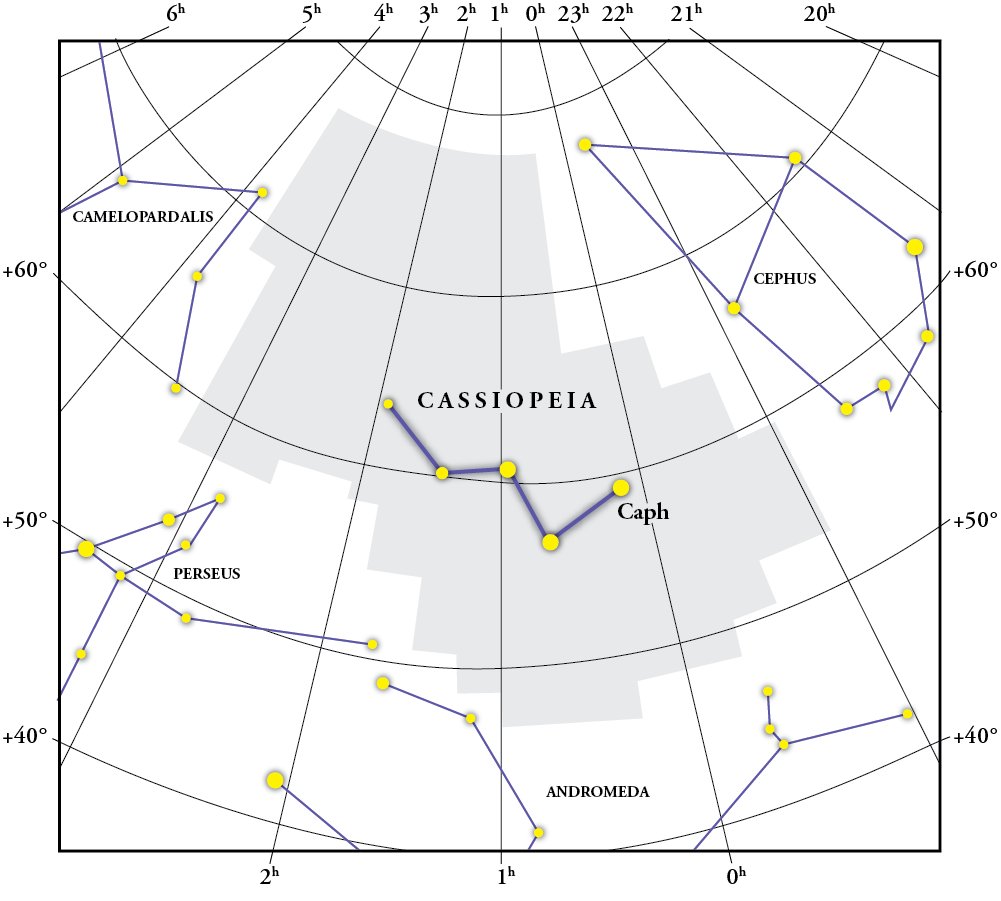


Schedar is sometimes listed as a suspected variable even though it has not been observed to vary in brightness since the 19th century. The name Schedar comes from the Arabic şadr, meaning “chest.” It refers to the star’s position in Cassiopeia, marking the queen’s heart. It has an estimated age of 220 million years. It is 794 times more luminous than the Sun with a surface temperature of 4,552 K. It has a mass 3.98 times that of the Sun and has expanded to a size of 45.39 solar radii as it evolved away from the main sequence. It shines at magnitude 2.24 from a distance of 228 light years. Schedar, the brightest star in Cassiopeia, is classified as an orange giant of the spectral type K0 IIIa. The five stars of Cassiopeia’s W, image: Wikisky Schedar (Alpha Cassiopeiae) Schedar is the largest, with a radius 45.39 times solar. Gamma is also the most massive and luminous in the group, with a mass 17 times that of the Sun and a luminosity of 34,000 Suns. The most distant star in the W is Gamma Cassiopeiae, located 550 light years away. It is classified as a subgiant of the spectral type B0.5IVe.Ĭaph is also the smallest, least massive and luminous, and nearest of the five stars, lying 54.7 light years away. Even though it is the youngest of the five stars, Gamma Cassiopeiae has already come to the end of its main sequence lifetime. The oldest in the celestial quintet is Caph (Beta Cassiopeiae), a white giant with an estimated age between 1.09 and 1.18 billion years, and the youngest is Gamma Cassiopeiae, which is only 8 million years old. The stars that form the W asterism may appear similar in brightness, but are in fact very different from each other. These four stars appear similar in brightness, with apparent magnitudes ranging from 2.24 to 2.68, while Segin is noticeably fainter at magnitude 3.35. Even though all five of them are considerably younger than the Sun, four (all except Segin) have already evolved away from the main sequence and entered the final stages of their life cycles. The stars themselves are quite interesting. Depending on the time of night, the stars may appear as a bright W or M in the sky. In the order of brightness, these are Schedar (Alpha Cassiopeiae), Caph (Beta Cassiopeiae), Gamma Cassiopeiae, Ruchbah (Delta Cassiopeiae), and Segin (Epsilon Cassiopeiae). The W asterism makes it very easy to find these on a clear night.Ĭassiopeia’s W is formed by five bright stars at different evolutionary stages, located at different distances. The Heart and Soul Nebulae, the Double Cluster, the Pacman Nebula, the Bubble Nebula, and the open clusters Messier 52 and Messier 103 are among the many deep sky objects that lie in this area.
#Constellation cassiopeia full
Andromeda was saved by the hero Perseus and, as punishment for her vanity, Cassiopeia was placed among the stars and forced to circle the north celestial pole on her throne, spending half of the time upside down.Ĭassiopeia is located in a region of the sky full of bright, large nebulae and open star clusters that make easy targets for small telescopes. As punishment, Poseidon sent a sea monster, represented by the constellation Cetus, to ravage the land and asked that Cassiopeia’s daughter Andromeda be bound to a rock and left for Cetus. She was placed in the sky after offending the sea god Poseidon by boasting that she was more beautiful than the Nereids (sea nymphs). In Greek mythology, Cassiopeia was the queen of Aethiopia and wife of King Cepheus. The W-shaped asterism is the most visible part of Cassiopeia’s constellation figure, which represents the Greek mythical queen bound to her throne.Ĭassiopeia is one of the 48 constellations catalogued by the Greek astronomer Ptolemy in the 2nd century CE. Its five brightest stars form the distinctive shape of a W in the northern night sky. The constellation Cassiopeia has long been known by its popular nickname, the W constellation.


 0 kommentar(er)
0 kommentar(er)
